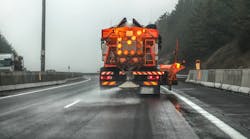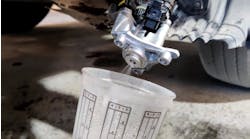Corrosion is an ever-present and costly issue for fleets. From environmental conditions to road salt and debris, corrosion is inevitable and will always take its course.
There’s no way to avoid or stop corrosion. However, there are ways to prolong the life of a fleet’s vehicles and their components. It is important to catch corrosion early and to take proper steps to slow the process down.
Understanding the corrosion process
Corrosion is a process in which a material slowly breaks down or weakens through a chemical reaction. This chemical reaction attacks surfaces exposed to a gas or liquid from the surrounding environment. Warm temperatures, acids, and salts accelerate the chemical reaction. If left untreated, corrosion can weaken the vehicle body, system, or component to the point of possible failure.
It is a natural process that is irreversible. Once corrosion begins, the deterioration of material quickly spreads to neighboring areas. All metals corrode over time, some faster than others. Electrical systems and non-metal components are also susceptible to corrosion. It’s a problem every fleet has and will continue to face time and time again.
The toll corrosion takes on vehicles can result in breakdowns, safety concerns, loss of productivity, and high repair and replacement costs.
Geographic locations that are humid or wet are more prone to corrosion than hot and dry climates. Moisture – whether through humidity and condensation or through precipitation such as rain or snow – plays a leading role in causing corrosion, especially for metals. Moisture sits on the vehicle and its components until it eventually evaporates.
Moisture can seep into the smallest of areas including fasteners, gaskets, or within chips and dents. Say a driver is going down a paved highway and the tire kicks up a stone that causes a small crevice on the body of the vehicle. Moisture can easily find its way into the crevice, coupled with exposure to oxygen, the corrsion process starts.
Additionally, when a component comes under extreme stress over time with heavy loads, it may crack. This crack, either in metal, paint, or other material, allows moisture to enter the component or system, leading to corrosion.
De-icing products used on roadways and parking lots in colder climates can be highly corrosive. Road salts - whether sodium, magnesium, potassium, or calcium chloride – may be good at breaking up snow and ice to improve driving conditions but are not good for vehicles. Salt accelerates the chemical reaction of corrosion by absorbing moisture from the air. With moisture, salt is able to stick onto vehicle’s components until the next time the vehicle is cleaned or washed thoroughly.
Areas of concern
It is imperative for fleets to check for corrosion often and to look for any signs that may suggest potential areas of concern.
“If corrosion is left unchecked, it could cause structural weakness to the vehicle and its components and could become dangerous to use,” says Scott Colvin, brand manager, commercial coatings, U.S. and Canada, PPG. PPG develops paints, coatings, and specialty materials for vehicles. “This will force the vehicle off the road for extensive repairs, or worse - the vehicle can be too damaged by corrosion to repair. Inspect vehicles and components as often as possible and repair corrosion early, while the areas are still small. It is much easier and more cost-effective to repair small corroded areas versus large areas.”
Although corrosion can occur almost anywhere on a truck or trailer, there are some areas that are more susceptible than others. In addition, there are areas and systems that some may not think about where corrosion can occur.
The bottom half of the truck and trailer is typically the first place to look for premature corrosion. This area is known as the “hot zone.” The hot zone covers all parts and components up to four feet above the road, where the most moisture and salt from the roads may come into contact with the vehicle.
“Due to their location on the vehicle, wheel-end components are positioned in one of the most corrosive environments on the vehicle,” says Jim Rosema, director of wheel-end products, STEMCO. STEMCO is a manufacturer of commercial vehicle wheel end, braking, and suspension components. “If corrosion, due to improper care or maintenance, makes its way into the wheel end, this can cause premature failure of these safety-critical components.”
“Fleets should want to look into preventing or controlling corrosion,” adds Emily Hardsock, inbound marketing specialist, IMI. IMI provides solutions to address tire maintenance and wheel safety for the commercial trucking industry. “If fleets are not utilizing measures to protect against corrosion, they will see [a] premature [end] to their wheels and tires. This will cause them to need replacements sooner. In turn, this can lead to downtime, loss of money, and decreases safety at the wheel end.”
When corrosion occurs between the brake shoe and lining, this is known as rust jacking. Eventually, the buildup can cause cracks in the brake lining, weakening the truck’s ability to brake safely. Factors such as de-icing chemicals, moisture (due to improperly matched components), and an extensive amount of braking can all lead to rust jacking.
Corrosion doesn’t just encroach on ferrous metals, like steel or iron. It also affects other materials such as non-ferrous metals and composite or reinforced rubber materials. In the hot zone, there are two types of non-ferrous corrosion that can typically occur: wet corrosion, or soakage, and dry corrosion, or dry rot.
“Either the product is sitting in oils, water, or liquids for lengthy periods of time; or [the product is] sitting in the sun being affected by UV rays,” explains Brian Herrington, territory sales manager at Atro Engineered Systems, Inc. Atro Engineered Systems, Inc. engineers polyurethane parts for heavy trucks and trailers.
The electrical system is another area of concern.
“When people hear corrosion, they think of rusty frames and wheels, but electrical is also a big deal,” says Joe Puff, vice president of truck technology and maintenance, NationaLease. NationaLease is a full-service truck leasing organization in North America that provides fleet management services for private fleets and transportation service providers.
The battery, battery cables, and the 7-way trailer connector are electrical components highly susceptible to corrosion, Puff notes. The battery and battery cables are at higher risk due to their proximity and exposure to battery acid. The 7-way trailer connector is more often exposed to moisture because of the frequent plugging and unplugging during trailer coupling and uncoupling.
Ultimately, any vehicle wiring connection where water may enter can cause corrosion. Examples include anti-lock brake systems (ABS), sensors, telematics devices, safety systems, wiring harnesses, lighting harnesses, and more, which can be impaired by just a small amount of corrosion. Not to mention, if one component fails due to a wiring malfunction it can cripple the whole system.
“Everything communicates electronically nowadays, and we have up to ten modules on a vehicle,” says Chris Disantis, director of purchasing and training, Aim NationaLease. Aim NationaLease is a full-service truck and trailer leasing company and member of NationaLease. “If those modules are not communicating, the truck will no longer run.”
High-power items, such as the battery and liftgate, are more prone to corrosion, Disantis adds. The battery is out in the open and tough to cover completely. If it is not properly maintained, corrosion will start and spread quickly.
Best practices for preventing corrosion
Corrosion is going to happen; it’s just a matter of time. It is up to fleets to decide their course of action on how best to prolong the life of the truck or trailer and its components as long as possible.
One option is to adopt a corrosion prevention program. This program can include items such as winterizing the vehicle by applying protective coatings or inhibitors onto the body and components, scheduling thorough inspections, and specifying the right components.
Ideally, a program should be established when the truck or trailer is new to ensure all seals, coatings, materials used, et cetera, are accounted for on the vehicle. But, even if a tractor or trailer has been in a fleet for some time, it is never too late to start a corrosion prevention program.
“If [fleets] don’t have a corrosion prevention program in place it’s a good idea to start one because if nothing else [the fleet] can at least start to treat the equipment and will get a couple extra years out of [the vehicles],” says Brad Ryckert, national fleet sales manager, SKF, a global technology provider.
Keeping the truck and trailer clean is imperative and should be included in the corrosion prevention program.
“A regular and proper wash system is vital to a fleet’s longevity,” says Matthew Young, industrial sales manager at Krown Industrial, a manufacturer of corrosion inhibitors, lubricants, and penetrants. In addition to a regular wash, Young suggests using a corrosion inhibitor as part of a preventive maintenance program.
Typically, corrosion doesn’t form on large surfaces, it forms where moisture sits. “You can’t introduce a physical coating to protect those [smaller places such as a nut and bolt], so something that is lighter, that is oil-based, and has the ability to penetrate and displace moisture already there is key,” Young adds.
Keeping all areas of the truck and trailer clean, particularly in the hot zone, and making sure that any detergents and soaps are completely washed off during the cleaning process will help prevent corrosion. If detergents or soaps are left to dwell on the surface, the cleaning solutions used can cause corrosion, especially with some of the acids being used in the truck washes, notes Brandon Uzarek, field engineer, Accuride. Accuride is a manufacturer of commercial vehicle wheels and wheel-end components and assemblies.
Another best practice is selecting the right metals and materials to use, both when purchasing new equipment and when using replacement parts. Consider the surroundings that each component will be subject to since all types of materials corrode at different rates and accelerate faster in different environments. Ideally, it is best to select such metals and material when first specifying the vehicle.
“OEMs are doing a much better job at corrosion protection, but most don’t build [the] base vehicle assuming every vehicle will operate in the most extreme conditions,” says NationaLease’s Puff. “Therefore, a fleet should consider alternative components and treatments.”
Cost becomes a main factor. Less corrosive metals typically cost more upfront but can significantly reduce the vehicle’s long-term life cycle costs – not only maintenance and appearance costs, but also the resale value – Puff adds. Not to mention it’s important to consider the environment and weather that truck and/or trailer will be operating in to ensure value in the long run.
Puff advises stainless steel, aluminum, brass, copper, and bronze are metals that corrode at a slower rate. These metals may be used in place of some traditional iron or steel applications, and in such cases may be more cost-effective.
An additional option for fleets when first specifying and purchasing a trailer is galvanization. Hot-dip galvanizing is a process in which steel is dipped into molten zinc to form a coating, resulting in a barrier to protect against corrosion. It doesn’t block out corrosion completely or indefinitely, but it does slow it down.
“It’s becoming more prevalent now in the U.S.,” says Darry Stuart, president and CEO of DWS Fleet Management Services, an independent transportation and fleet management business. “What really started [the rise in galvanizing] is the residual value of the trailers going down to the point where one couldn’t justify getting rid of a trailer… nobody wants to buy a trailer that is really corroded underneath.”
Areas on the trailer common for hot-dip galvanizing include the rear header, cross members, upper couplers, and the suspension. Although the process has been proven to extend the life of trailers, the decision comes down to cost. “It depends on the company and how long they plan to keep their trailers,” says Stuart. “It can be a hard sell, especially for fleets who purchase many or even hundreds of trailers at a time.”
When it comes to preventing rust jacking, applying a protective coating to the brake table will mitigate the effects of the corrosion buildup. “Using quality reline programs and parts such as OE is also beneficial,” states Atro’s Herrington. Rust jacking is not as common as it once was. This is because brake OEMs have developed processes and coatings to help reduce this to a degree, Herrington notes.
Lastly, a best practice for electrical systems is to keep the inputs clean at all times. Every time a repair is done or wires are unhooked and hooked back up again, moisture could be introduced to the system. Properly sealing the system each and every time prevents water, debris, and salt (particularly in the winter months) from entering the system. Applying a dielectric lube or an inhibitor is another good option to consider.
“Most corrosion happens [in electrical systems] because people touch the system and they take a component apart and they don’t put it back together properly or they put a prick into a wire, which allows corrosion to come into the wire,” Aim NationaLease’s Disantis says.
Regardless of how fleets decide to prevent and control corrosion, the sooner precautions are taken the better. Corrosion can be slowed down, but it can’t be fixed when it’s already there. Time is of the essence.
“For every action, there is a comparable or greater reaction,” says Herrington. “Corrosion is certainly true of that.”




